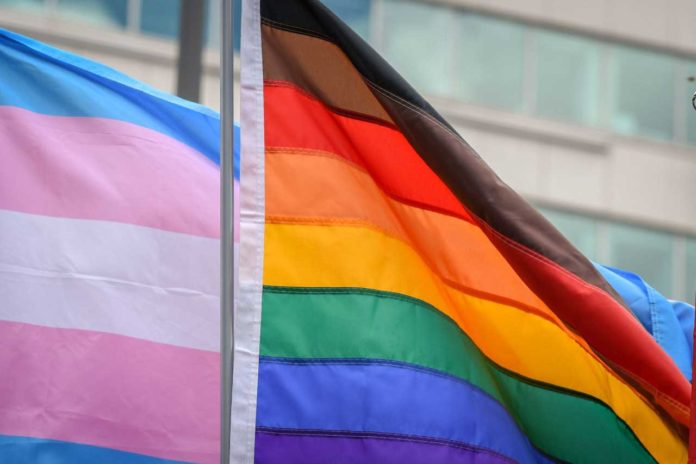The first Pride parades took place in America in 1970, and the concept quickly went international. But one LGBTQ export is uniquely Philadelphia’s, and it has grown steadily more popular and relevant this year: the black and brown-striped rainbow flag.
For the month of June, the Philadelphia Pride flag was shown across the country, raised in front of government buildings, donned by people participating in virtual pride events, and hung in the windows of homes. Most recently, the flag has been used in Black Lives Matter protests in myriad cities.
The city of Tampa, Florida hung the flag outside their city hall, same with Boulder, Colorado and several cities in California. Regionally, both Upper Darby and New Castle counties raised the flag. And in Bucks County it was hoisted in front of the administration building, marking the first time the government there has raised a LGBTQ pride flag.
“When I introduced this flag in 2017 to uplift the voices and experiences of LGBTQ people of color,” Amber Hikes said on Instagram, “I couldn’t have imagined its global impact three years later. Let this be a reminder that if your Pride isn’t intersectional – if it isn’t protest, it’s irrelevant. The revolution is now.”
The inclusive “More Color, More Pride” flag was created by the Philadelphia Office of LGBT Affairs in partnership with local advertising agency Tierney, and it was introduced at a City Hall ceremony in June 2017.
Despite Hikes receiving hate mail and death threats following its unveiling, the flag’s usage grew steadily. In 2019, the flag was broadcast on the season finale of the television show “POSE.” This year, it was placed on Nike and Converse sneakers. Even Gritty, the orange mascot of the Philadelphia Flyers hockey team, has marched with the flag during Pride events.
When Manchester, England decided to use the flag during their 2019 Pride celebration, it prompted a debate which has occurred since the flag’s creation: what, and who, should the fight for LGBTQ equality include? Some people felt that the flag should represent only sexuality, while others embraced the idea of greater representation and solidarity.
Hikes addressed the idea of solidarity, writing that this year “we are at a moment where the intersection of our identities and oppressions are front and center. Our country is finally waking up to the realities of violence, injustice, and inequities that Black people have experienced and died from for the last 400 years in this country — and that awakening is happening during Pride. We are at this moment where so many people now understand the need for an LGBTQ flag that centers Black lives, voices, and leadership.”
The rainbow Pride flag has been evolving since its creation in 1978 by Gilbert Baker. In the first version, which was used in the San Francisco Gay Freedom Day Parade, Baker put eight stripes on the flag, including hot pink and turquoise blue. When he approached the Paramount Flag Company to mass produce the flag, they did not have hot pink available, so a seven-color flag was sold. In 1979, the indigo stripe was removed to make the number of stripes an even six. And in 1994 Baker was again able to use his original eight colors to create a mile-long rainbow flag for the Stonewall 25th anniversary in New York City.
Flags have always been powerful symbols. In his essay “The nature of flag power,” anthropologist Robert Shanafelt writes “Not only does the display of a flag suggest social solidarity, it simultaneously demands political deference.” By adding black and brown stripes, the city of Philadelphia made a statement that the LGBTQ community, by its very symbol, stands with the people those stripes represent. It’s a statement that has caught on in many cities around the country.
Since 2017, other inclusive rainbow flags have been created in addition to Philadelphia’s. Daniel Quasar, a graphic designer in Portland, Oregon created a rainbow flag that includes both black and brown stripes as well as the colors of the transgender flag. And still more cities are looking to create their own version. Boston has said their city’s new Pride flag will be unveiled next year, and in San Francisco, over 650 people have signed a petition to make the Castro pride flag more inclusive.In 2017, just before the release of the “More Color, More Pride” flag, Hikes told PGN “This is not going to just be in Philadelphia. This is going to take the nation by storm. I believe that very deeply. This is an opportunity for the community to come together and celebrate not just Pride but also the community members whose voices and experiences that so often get overlooked. To me, this is a chance to stop saying ‘We’re inclusive’ and to actually begin showing it.”
